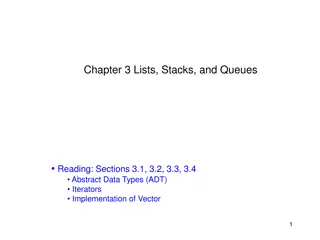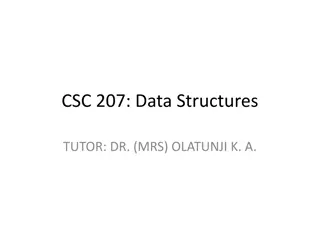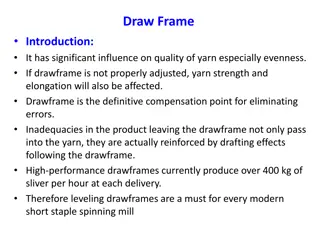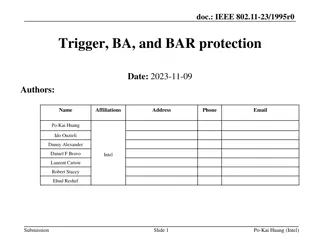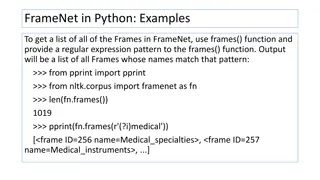CSc 235: Stacks & Frames
This content delves into the allocation of automatic variables within stack frames, comparing SPARC and x86 architectures. It discusses topics such as stack organization, variable declaration, multi-dimensional arrays, and memory allocation. Additionally, it explores the program address space, local variables, dynamic variables, and the hierarchy of function frames. Understand the differences in register sets, parameter passing mechanisms, and handling of automatic variable areas in SPARC versus x86 systems.
Download Presentation

Please find below an Image/Link to download the presentation.
The content on the website is provided AS IS for your information and personal use only. It may not be sold, licensed, or shared on other websites without obtaining consent from the author.If you encounter any issues during the download, it is possible that the publisher has removed the file from their server.
You are allowed to download the files provided on this website for personal or commercial use, subject to the condition that they are used lawfully. All files are the property of their respective owners.
The content on the website is provided AS IS for your information and personal use only. It may not be sold, licensed, or shared on other websites without obtaining consent from the author.
E N D
Presentation Transcript
CSc 235: Stacks & Frames Allocation of Automatic Variables Author: Dr. Spiegel
Topics Stack Frame (Activation Record) SPARC vs x86 Automatic Variables Local declarations Arrays One-dimensional Multi-dimensional (nested) Multi-level Structures Allocation Access Alignment
Program Address Space Program Address Space Low memory Code Section Code Static variables OS information Heap Section Dynamic variables Stack Section Automatic variables High memory
Stack section Stack section Contains automatic variables of the functions Contains frame information for each call of a function Stack grows from high memory to low memory Frames are allocated backwards in memory The stack pointer is at the beginning of the frame, at its lowest address. In x86, local variables are allocated at the beginning of the frame The stack pointer is moved backwards to make room Really a stack of Frames
Stack View Stack View Stack Top %sp -> Low memory Function Frame 3 Function Frame 2 Function Frame 1 High memory Main Frame
SPARC vs x86 Register Set SPARC has 128 general use 32-bit registers Each function has 24 of those registers available 8 shared with caller and 8 with callee X86 has no similar mechanism 16 general purpose registers Shared by all functions Preservation is by saving in frame Stack frame has room set aside for 16 registers Parameter Passing SPARC has area for parameters in frame X86 assumes pass is always by register if less than six arguments 8
SPARC vs x86 Automatic Variable Area Variable size in SPARC Not automatically accounted for in x86 Allocate memory Extend frame Must be word (16 bit) divisible Return area in SPARC frame has no x86 Equivalent Compiler Stuff area in SPARC has no equivalent Maintaining PC for each call of a function Accomplished by caller pushing the return address before the call 9
Automatic (local) Variables in x86 To allocate space for local variables Subtract required space from %rsp Must be next multiple of 16 to keep stack properly aligned Designate space within allocated memory for each variable Must be aligned Best to have some sort of legend Offset forward from %rsp Good reason to use m4 preprocessor To access a local variable The address is the offset from the stack pointer Recorded in your legend Use of define() 10
Automatic Variables Example AddXY.m Uses define() to explicitly name offsets and registers Allocates space on run-time stack for two integers Must allocate 16 bytes to keep stack aligned Unaligned access results in a bus error Only need four bytes per integer Reads directly to stack frame Use of define () complicates instructions for loading variables Can t use leaq nor displacement prefix AddXY_NoDefine.s Doesn t use define() MUCH harder to follow 11
Array Storage Array Storage Consider an array A in C defined as follows: some_type A[array_size] A compiler would need to set aside enough storage for the entire array. The following formula is used by the compiler: bytes_needed = array_size * size of some_type
Examples Examples Assume automatic storage is desired int a[10] requires 40 bytes double f[25] requires 200 bytes char ch[25] usually requires 28 bytes (why?) customertype customers[100] requires 8000 bytes assuming a customertype needs 80 bytes.
Array Addressing Array Addressing Once stored, how is the address of a component computed? Depends on how the elements are stored: big-endian little-endian Big-endian stores the low index in lower memory and the higher indices in high memory Little-endian stores the low index in high memory and the high indices in low memory Comes from the way numbers are stored
Big Big- -endian vs Little endian vs Little- -endian Storing 0x12345678 Storing 0x12345678 endian Low memory 12 78 34 56 56 34 78 12 Big-Endian Little-Endian High memory
Big Big- -endian vs Little endian vs Little- -endian endian Low memory A[0] A[size-1] A[1] A[1] A[0] A[size-1] High memory Big-Endian Little-Endian
Big Endian Array Storage Big Endian Array Storage Most compilers store arrays in big endian order Address of a component A[I] is then computed using the following formula: address(A[i]) = address(A) + i*(size of component) We are writing in assembler so we can choose big or little endian
Computing Address of A[i] Computing Address of A[i] A[0] Address of A A[1] i components A[I] Address of A[I] A[size-1] Size of 1 component
Array Storage Array Storage Setting aside enough storage for the entire array Must also maintain stack alignment Each frame must be word addressable %rsp MUST be divisible by 16 The formula used by the compiler is modified: Bytes needed is next multiple of 16 past(local variables size) Example ArrayEx1.s
Structures Structures A structure is similar to a class, where all data members are public. In C structures do not have member functions. The data members of a structure are stored as a composite unit. Each member has a address (offset) measured from the beginning of the structure
Example Example Consider the customer structure defined below: typedef struct { char name[24]; int age; int salary; } customer_type; customer_type customer;
Addressing Structure Components Addressing Structure Components To address a component of a structure, we use the formula: addr(component) = addr(structure) + offset of component from beginning of structure It is customary to use Big Endian storage for structures, so the offset is positive.
Customer Struct Customer Struct Customer Low memory Offset of name: 0 name Offset of age: 24 age salary Offset of salary: 28 High memory Example StructEx.m
Structure Containing an Array r struct rec { int a[4]; size_t i; struct rec *next; }; a 0 i next 24 32 16 Structure represented as block of memory Big enough to hold all of the fields Compiler determines overall size + positions of fields Machine-level program has no understanding of the structures in the source code Fields ordered according to declaration Even if another ordering could yield a more compact representation Only when the code is a result of compilation
Structures & Alignment Unaligned Data struct S1 { char c; int i[2]; double v; } *p; c i[0] i[1] v p p+1 p+5 p+9 p+17 Aligned Data Primitive data type requires K bytes Address of each element must be multiple of K c i[0] i[1] v 3 bytes 4 bytes p+0 p+4 p+8 p+16 p+24 Multiple of 4 Multiple of 8 Multiple of 8 Multiple of 8
Specific Cases of Alignment (x86-64) 1 byte: char, no restrictions on address 2 bytes: short, lowest 1 bit of address must be 02 4 bytes: int, float, lowest 2 bits of address must be 002 8 bytes: double, long,char *, lowest 3 bits of address must be 0002 16 bytes: long double (GCC on Linux) lowest 4 bits of address must be 00002
Satisfying Alignment with Structures Within structure: Must satisfy each element s alignment requirement Overall structure placement Each structure has alignment requirement K K = Largest alignment of any element Initial address & structure length must be multiples of K Example: K = 8, due to double element struct S1 { char c; int i[2]; double v; } *p; c i[0] i[1] v 3 bytes 4 bytes p+0 p+4 p+8 p+16 p+24 Multiple of 4 Multiple of 8 Multiple of 8 Multiple of 8
Meeting Overall Alignment Requirement struct S2 { double v; int i[2]; char c; } *p; For largest alignment requirement K Overall structure must be multiple of K v i[0] i[1] c 7 bytes p+0 p+8 p+16 p+24 Multiple of K=8
Arrays of Structures Overall structure length multiple of K Satisfy alignment requirement for every element struct S2 { double v; int i[2]; char c; } a[10]; a[0] a[1] a[2] a+0 a+24 a+48 a+72 Example ArrayOfStruct.m v i[0] i[1] c 7 bytes a+24 a+32 a+40 a+48


